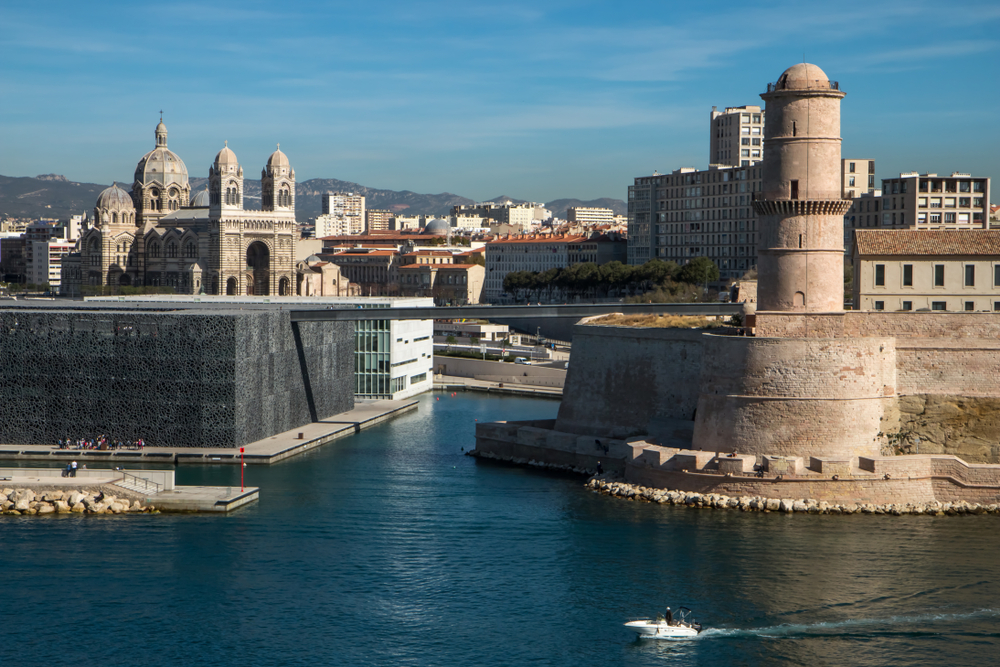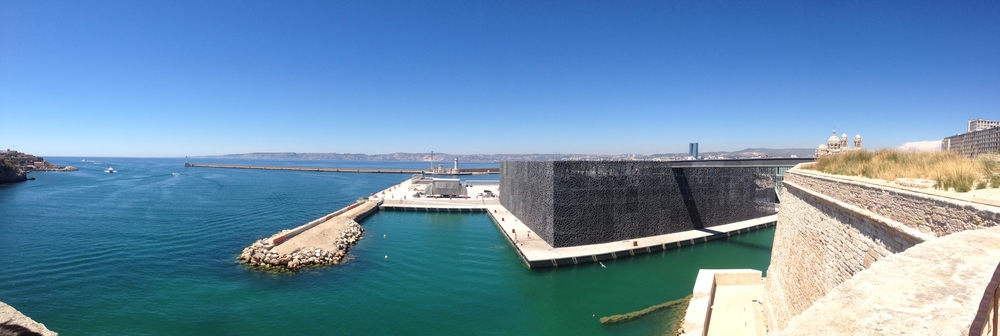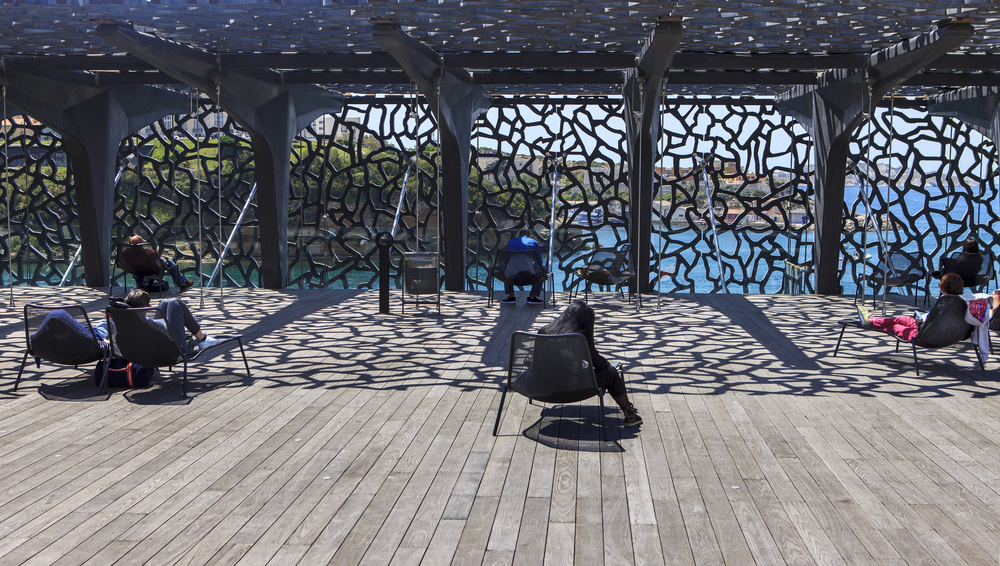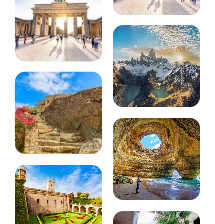
Visiting the MUCEM in Marseille, practical information

Standing majestically at the entrance to Marseille’s Old Port, the MUCEM (Musée des Civilisations de l’Europe et de la Méditerranée) is one of the most emblematic cultural sites in the south of France. Inaugurated in 2013, the year when Marseille was European Capital of Culture, this exceptional national museum brilliantly blends contemporary architecture and historical heritage. Set between the J4 building designed by Rudy Ricciotti and the majestic Fort Saint-Jean, the MUCEM offers a unique cultural experience centred on Mediterranean civilisations, with fascinating exhibitions, breathtaking panoramic terraces and outdoor spaces where you can stroll facing the sea.

See also the Marseille guide :
- The 10 most beautiful beaches in Marseille
- The 9 most beautiful districts to visit in Marseille
- 20 not-to-be-missed excursions around Marseille
- The 5 best straw huts around Marseille
- Visit Marseille’s History Museum
What is the MUCEM?
The MUCEM, an acronym for the Museum of European and Mediterranean Civilisations, is much more than just a museum. It is the first national museum to be located outside Paris, an exceptional place that explores the cultural, historical and anthropological riches of the Mediterranean basin. Spread over three main sites – the J4 building, Fort Saint-Jean and the Centre de Conservation et de Ressources (CCR) – the MUCEM offers a fascinating immersion in the history of the civilisations that have shaped the Mediterranean identity, from Antiquity to the present day.
This innovative museum boasts exceptional permanent collections, complemented by high-quality temporary exhibitions covering a wide range of themes: migration, religion, gastronomy, trade, contemporary art and geopolitics. The MUCEM stands out for its desire to build bridges between past and present, between tradition and modernity, offering visitors an in-depth look at the contemporary issues facing the Mediterranean. Let theNavaway audioguide for Marseille guide you on your discovery of the city, helping you to make the most of your visit.
The history of the MUCEM

The MUCEM adventure began in earnest in 1992, when Marseille applied to become European Capital of Culture in 2013. The ambitious project was to create a museum of international stature dedicated to the civilisations of the Mediterranean, the heir to the Musée national des Arts et Traditions populaires in Paris. The chosen location, the former J4 mole at the entrance to the Old Port, reflects the desire to create a dialogue between the city, its port and the sea.
Architect Rudy Ricciotti, in association with Roland Carta, won the competition in 2003 with a bold architectural project: a concrete cube with a latticework inspired by Mediterranean lacework. Work began in 2009 and the museum opened its doors on 7 June 2013, immediately becoming a major architectural symbol of Marseille. Fort Saint-Jean, a historic monument dating from the 12th century, was integrated into the project after meticulous restoration, creating a striking link between medieval heritage and contemporary architecture.
Since its inauguration, the MUCEM has welcomed over 8 million visitors and established itself as an international cultural benchmark. In 2015, it was awarded the prestigious Council of Europe Museum Prize, in recognition of its innovative approach and its mission of intercultural dialogue. Today, a visit to the MUCEM in Marseille means discovering a lively place where history meets current affairs, where cultures engage in dialogue and where architecture sublimates heritage.
The exceptional architecture of the MUCEM

The J4 building: an architectural feat
The J4 building, the contemporary heart of the MUCEM, is a real architectural feat by Rudy Ricciotti. This 72-metre cube is distinguished by its ultra-high-performance fibre-reinforced concrete (UHPC) shell, which is no more than a few centimetres thick. The façade is adorned with an openwork mesh inspired by traditional Mediterranean claustras and lacework, creating a magical interplay of light and shadow inside the museum.
This concrete lacework, the building’s signature feature, allows Mediterranean light and sea breezes to filter through while protecting the exhibition spaces. The J4 building houses 3,690 m² of exhibition space on two levels, a bookshop-boutique, an auditorium and the Le Môle Passédat (MCM) restaurant on the top floor, offering spectacular views over the Mediterranean. The architecture perfectly embodies the museum’s philosophy: to create a dialogue between inside and outside, between heritage and modernity.
Fort Saint-Jean: a witness to history
Fort Saint-Jean, an emblematic historic monument, is the second architectural pillar of the MUCEM. Built in the 17th century on the orders of Louis XIV, this military fort has overlooked the entrance to the Old Port for centuries. It stands on a site steeped in history, where remains of the first Greek occupation in the 6th century BC have been discovered, testifying to the exceptional historical richness of the site.
Restored and integrated into the MUCEM in 2013, Fort Saint-Jean has retained its historic character while opening up to the public with new facilities. Temporary exhibitions are held in rooms steeped in history, while the Mediterranean gardens offer a bucolic stroll with incomparable views over the sea and the city. The Tour du Roi René (King René Tower), the Chapelle Saint-Jean (Saint John’s Chapel) and the old fortifications are all fascinating architectural testimonies to be discovered during your visit.
Gateways: a symbolic link
Two spectacular pedestrian bridges link the J4 building to Fort Saint-Jean, creating a unique aerial route over the water. The first, 130 metres long, overlooks the fort and offers breathtaking views of the Old Port, La Major Cathedral and the rooftops of Marseille. The second footbridge connects the fort to the J4 esplanade, making it easier to move between the different areas of the museum.
These footbridges are not simply functional links: they embody the very concept of the MUCEM, that of creating bridges between cultures, eras and civilisations. They allow visitors to enjoy a unique architectural experience, suspended between sky and sea, while admiring the exceptional panoramas offered by this privileged site at the entrance to the port of Marseille.
What to see and do at the MUCEM

1. Permanent exhibitions
The MUCEM’s permanent exhibitions are the heart of the museum’s cultural offering. The Galerie de la Méditerranée, the museum’s flagship exhibition, offers an exceptional chronological and thematic journey through 3,000 years of Mediterranean history. You’ll discover archaeological objects, works of art, ethnographic evidence and contemporary installations that illustrate the richness and diversity of civilisations in the Mediterranean basin.
The themes covered include the invention of agriculture and divinities, city-states and empires, Jerusalem and the three monotheistic religions, ancient citizenship and the great voyages of discovery. The permanent collections also explore contemporary issues such as migration, trade and cultural exchanges, and the conflicts and cooperation that have shaped the Mediterranean identity. The immersive scenography and multimedia features make the visit particularly lively and accessible to all visitors.
2. Temporary exhibitions
The MUCEM regularly presents high-quality temporary exhibitions that explore specific themes linked to Mediterranean civilisations. These exhibitions, which are renewed several times a year, cover subjects as varied as Mediterranean gastronomy, contemporary art, fashion, photography, architecture and current geopolitical issues.
Temporary exhibitions occupy different areas of the museum, both in the J4 building and in Fort Saint-Jean, offering very different atmospheres depending on the location. Some exhibitions call on internationally renowned contemporary artists to create installations specifically for the MUCEM’s spaces. We recommend that you consult the museum’s official website before your visit to find out about the current programme and make sure you don’t miss out on any of the cultural events on offer.
3. The Migration Garden
The Jardin des Migrations, in the heart of Fort Saint-Jean, is a unique botanical and poetic experience. This landscaped trail is a living illustration of the cultural and commercial exchanges that have shaped Mediterranean flora over the centuries. You’ll discover more than 250 plant species from the Mediterranean basin and beyond, bearing witness to the many influences that have enriched the region.
The garden is organised into several themed areas that tell the story of travelling plants: aromatic herbs, fruit trees, medicinal plants, essences from the Orient, Africa and the Americas. This bucolic walk also offers exceptional views over the sea, and is a welcome moment of relaxation during your visit to the MUCEM. The museum’s gardeners offer regular guided tours to help you discover the secrets of this extraordinary garden.
4. Panoramic terraces
The MUCEM’s panoramic terraces are some of the best views in Marseille. The terrace of the J4 building, which is freely accessible, offers an absolutely spectacular 360-degree panorama. From here, you can admire the Mediterranean stretching out to infinity, the majestic cathedral of La Major nearby, the whole of the Old Port, and in the distance, the emblematic silhouette of the Notre-Dame-de-la-Garde basilica watching over the city.
The terraces of Fort Saint-Jean offer a different, more intimate view of the port and the historic districts of Marseille. These outdoor spaces, veritable belvederes overlooking the Mediterranean, are particularly popular at the end of the day when the golden light of sunset illuminates the city. Don’t hesitate to linger there to photograph the city from its most beautiful angles and enjoy the unique atmosphere of the place.
5. Outdoor spaces and promenades
The outdoor areas of the MUCEM are accessible free of charge and are well worth a visit in themselves. The walk begins on the J4 esplanade, continues on the aerial walkways and continues in the gardens of Fort Saint-Jean. These routes offer a unique walking experience, between contemporary architecture and historic fortifications, between land and sea.
The ramparts of Fort Saint-Jean have been designed to provide a pleasant and safe walk, offering a variety of views of the Marseilles coastline. The fort’s shaded walkways, lined with Mediterranean vegetation, provide welcome cool spots on hot summer days. These areas are a great place to stroll for locals and visitors alike, allowing them to take full advantage of the site’s exceptional setting.
Download the audio tour to discover Marseille on foot and on your own
To extend your discovery after your visit to the MUCEM, theNavaway app offers you a complete audio tour to explore Marseille. This 7.3km itinerary takes you on a 3-hour tour of 24 of Marseille’s must-see sites, including the Old Port, the Panier district, La Major Cathedral and many other treasures of the city. Let yourself be guided by fascinating audio commentaries that reveal the history and secrets of Marseille as you walk at your own pace.
Practical information for visiting the MUCEM
Opening times
The MUCEM is open every day except Tuesday, with opening times that vary according to the season. From May to October, the museum is open from 10am to 7pm, while from November to April, the opening hours are 10am to 6pm. Last admission is 30 minutes before closing time. The museum is closed on 1 May and 25 December. The outdoor areas (footbridges, Fort Saint-Jean gardens, terraces) remain accessible free of charge during the site’s opening hours.
We recommend that you allow at least half a day to visit the MUCEM in comfort and enjoy all its facilities. A full visit, including the permanent and temporary exhibitions and the outdoor areas, can easily take 3 to 4 hours. To avoid overcrowding, it’s best to visit during the week or early in the morning at weekends.
Prices and tickets
The standard entrance ticket to the MUCEM costs €11 and gives access to all the exhibitions in the J4 and Fort Saint-Jean that are open on the day of your visit. A reduced rate of €7.50 is available for 18-25 year olds, jobseekers and holders of certain cards. The family ticket, at €18, allows entry for 2 adults accompanied by up to 5 children under 18. Admission is free for under-18s, people with disabilities and their carers.
Free admission is also offered to all visitors on the first Sunday of each month, during the Night of the Museums (mid-May) and the European Heritage Days (September). Tickets can be bought directly on site or booked online on the official MUCEM website (7 Promenade Robert Laffont, 13002 Marseille, rated 4.5/5 on Google for over 37,000 reviews). A free audioguide is available from your smartphone via visit.mucem.org.
How do I get to the MUCEM?
The MUCEM enjoys a privileged location, easily accessible from the centre of Marseille. By metro, get off at Vieux-Port (line 1) or Joliette (line 2) station, then allow around 10 minutes to walk. By tram, get off at République-Dames or Joliette (line 2). There are several bus routes serving the site: route 49 (stop: Église Saint-Laurent), route 83 (stop: MUCEM Saint-Jean) and routes 60, 82 and 82S (stop: MUCEM St Jean).
For those arriving by car, there are several pay car parks in the immediate vicinity: the Indigo Vieux-Port/Fort Saint-Jean car park (Esplanade J4) offers 526 spaces, the Q-Park Joliette car park (37 Rue Mazenod) and the Q-Park Vieux Port/Hôtel de Ville car park. There are also parking spaces reserved for people with reduced mobility. The MUCEM can also be reached on foot from the Vieux Port in around 15 minutes via a pleasant walk along the quays, which you can enhance by using the Navaway audio guide.
Accessibility and services
The MUCEM pays particular attention to accessibility for all. The museum is fully accessible to people with reduced mobility, with lifts, ramps and adapted routes throughout all the spaces. Wheelchairs are available free of charge by prior arrangement. The entrance to the J4 building is recommended for visitors in wheelchairs. Guide and assistance dogs are allowed in all areas of the museum.
The museum has a free cloakroom where you can leave your personal belongings, a bookshop-shop offering a selection of books and objects related to the exhibitions, and several food outlets. The Le Môle Passédat (MCM) restaurant, on the top floor of J4, serves refined Mediterranean cuisine with a view of the sea. Picnic areas have also been set up in the gardens of Fort Saint-Jean for those wishing to bring their own lunch.
Our tips for a successful visit
1. Book your tickets online
To avoid queues, particularly during the high tourist season and at weekends, we strongly recommend that you book your tickets online on the official MUCEM website. By booking online, you can access the exhibition spaces directly without going through the ticket office, saving you precious time. What’s more, you can consult the programme of temporary exhibitions in advance and organise your visit according to your interests.
2. Favour early morning or late afternoon
To make the most of your visit in optimum conditions, arrive as soon as the exhibition opens at 10am or in the late afternoon from 4pm. These time slots are generally less crowded, allowing you to appreciate the exhibitions with more serenity and take the time to observe the works without the crowds. The light on the terraces at the end of the day is particularly magical, providing ideal conditions for photographing Marseille and the Mediterranean.
3. Start with outdoor spaces
A wise strategy is to begin your visit by exploring the outdoor areas and terraces, which are accessible free of charge, before immersing yourself in the indoor exhibitions. This approach allows you to familiarise yourself with the exceptional architecture of the site, admire the panoramic views and understand the geography of the place. You can then devote yourself fully to the indoor exhibitions, without being tempted to leave during your visit.
4. Download the free audio guide
The MUCEM offers a free audioguide that you can access from your smartphone by logging on to visit.mucem.org or by flashing the QR codes in the exhibition areas. This tool greatly enhances your visit by providing detailed information on the works, themes and architecture of the museum. Remember to bring headphones and make sure your phone is sufficiently charged, or take an external battery with you.
5. Bring good shoes and sun protection
A visit to the MUCEM involves a lot of walking, particularly to explore the outdoor areas, take the footbridges and wander through the gardens of Fort Saint-Jean. Comfortable shoes are therefore essential. In summer, there is little shade on the terraces and outside areas, so bring a hat, sunglasses and sun cream. On windy days, which are common in Marseille, a light jacket may also be useful, especially on the aerial walkways.
6. Combine with other nearby sites
The MUCEM is located in a district rich in heritage. After your visit, extend your discovery by exploring the Cathedral de la Major, just a 5-minute walk away, or by strolling through the Panier district, Marseille’s oldest neighbourhood. The Old Port is also within easy reach. To make the most of your day and make sure you don’t miss out on any of Marseille’s treasures, let yourself be guided by the Navaway tour, which links all these iconic places in a coherent and rewarding way.
The MUCEM with children
The MUCEM is perfectly suited to family visits. The museum regularly offers educational workshops, guided tours adapted for children and free game books available at reception. These fun materials enable young visitors to discover the exhibitions in a fun, interactive way. The family rate (€18 for 2 adults and up to 5 children) makes the visit very affordable for large families.
The outdoor areas are an ideal playground for children: the footbridges offer guaranteed thrills, the gardens invite exploration, and the terraces allow you to run around safely with a breathtaking view. Pushchairs are allowed and can move around the museum easily thanks to the lifts and ramps. Baby-changing facilities are available in the toilets. But be sure to provide a variety of activities to keep the young ones’ attention throughout the visit.
Events and activities at the MUCEM
The MUCEM does not limit itself to its permanent and temporary exhibitions. Throughout the year, the museum offers a rich and varied cultural programme: lectures, film screenings, concerts, shows, artistic performances and meetings with authors, researchers and designers. These events provide an opportunity to explore in greater depth the themes addressed in the exhibitions, and to create moments for exchange and reflection on contemporary Mediterranean issues.
During the summer months, the terraces and gardens of Fort Saint-Jean host a number of popular open-air events, including sunset concerts, cinema screenings under the stars, and dance and theatre performances. These summer events help to make the MUCEM a dynamic cultural hub, far beyond its museum function. Check the museum’s calendar on its official website to make sure you don’t miss any of these exceptional cultural events.
Where to eat in and around the MUCEM?
The Le Môle Passédat (MCM) restaurant, run by Michelin-starred chef Gérald Passédat, offers a refined Mediterranean gastronomic experience on the top floor of the J4 building. The restaurant’s terrace offers an exceptional panoramic view of the sea, while you enjoy cuisine inspired by the flavours of the Mediterranean basin. If the gourmet restaurant is beyond your budget, the museum also has a café offering lighter, more affordable fare.
The area around the MUCEM is packed with dining options to suit all budgets. The Vieux-Port, just a few minutes’ walk away, is home to numerous fish and seafood restaurants where you can sample Marseille’s famous bouillabaisse. The Panier district, accessible via the Cathedral of La Major, offers small authentic restaurants and typical cafés. For a complete experience of Marseille’s gastronomy after your visit to the MUCEM, don’t hesitate to explore these emblematic districts by following the recommendations of the Navaway app.
In conclusion, a visit to the MUCEM in Marseille is much more than just a visit to a museum: it’s a unique cultural, architectural and sensory experience that plunges you into the heart of Mediterranean civilisations. With its fascinating exhibitions, bold architecture, Mediterranean gardens and breathtaking panoramas, the MUCEM perfectly embodies the soul of Marseille, a city of encounters and cultural cross-fertilisation. Whether you’re a history buff, a lover of contemporary art, a photographer in search of spectacular vistas or simply curious to discover an exceptional place, the MUCEM will fill you with wonder. Don’t forget to extend your discovery of the city of Marseille by exploring its other treasures thanks to the Navaway audio tour for Marseille, which will guide you through the historic streets, emblematic monuments and authentic districts of this fascinating city where East and West have always mingled.
Frequently asked questions (FAQ)
How long does it take to visit the MUCEM?
For a full tour of the MUCEM, including the permanent exhibitions, one or two temporary exhibitions and the outdoor areas, allow between 3 and 4 hours. An express visit concentrating on the main exhibitions can be done in 1? to 2 hours, but you risk missing some important aspects of the site.
Can I visit the outdoor areas of the MUCEM without paying?
Yes, the outdoor areas of the MUCEM (walkways, terraces, Fort Saint-Jean gardens) are accessible free of charge during the site’s opening hours. Only the exhibitions inside the J4 building and Fort Saint-Jean are subject to a charge.
Is the MUCEM accessible to people with reduced mobility?
Yes, the MUCEM is fully accessible to people with reduced mobility. The museum has lifts, access ramps and adapted routes. Wheelchairs are available free of charge on reservation. We recommend using the J4 building entrance.
Can I take photos at the MUCEM?
Yes, photography for personal use is permitted in most areas of the MUCEM, including the exhibitions. However, certain temporary exhibitions may prohibit photography for copyright reasons. Flash and tripods are prohibited. Outdoor areas and terraces are particularly suitable for photography.
Where can I park to visit the MUCEM?
There are several pay car parks in the immediate vicinity of the MUCEM: the Indigo Vieux-Port/Fort Saint-Jean car park on Esplanade J4 (526 spaces), the Q-Park Joliette car park (37 Rue Mazenod) and the Q-Park Vieux Port/Hôtel de Ville car park. There are also spaces reserved for people with reduced mobility.
Is there a restaurant at the MUCEM?
Yes, the Le Môle Passédat (MCM) restaurant, run by Michelin-starred chef Gérald Passédat, is located on the top floor of the J4 building. It serves refined Mediterranean cuisine with panoramic sea views. The museum also has a café for lighter fare. Picnic areas are available in the gardens of Fort Saint-Jean.
Does the MUCEM offer guided tours?
Yes, the MUCEM offers guided tours of 1 or 1? hours with specialist guides. These tours can cover the temporary exhibitions, the permanent collections or the architecture of the site. Bookings can be made on the official website or by telephone. A free audioguide is also available from your smartphone.
200 audioguided tours for cities all around the world
Download
